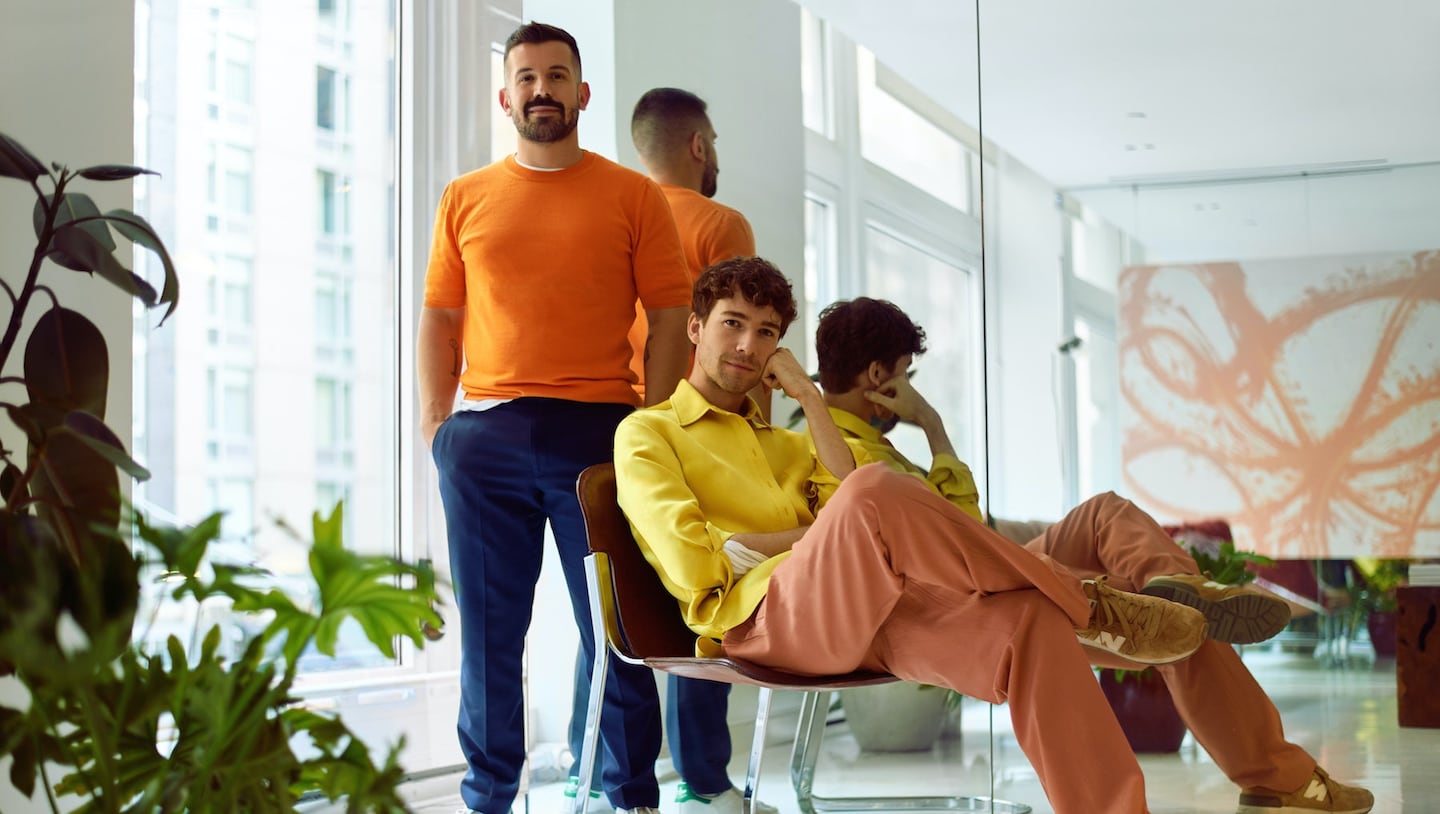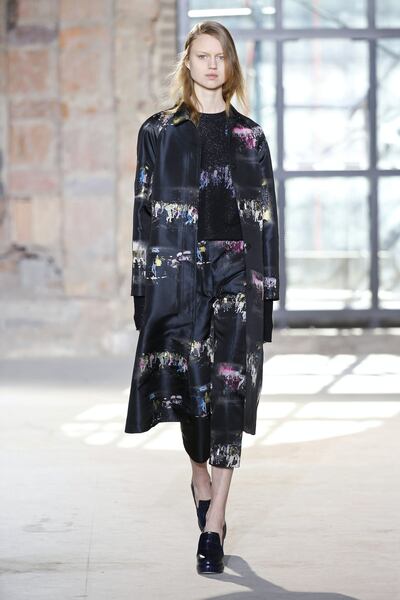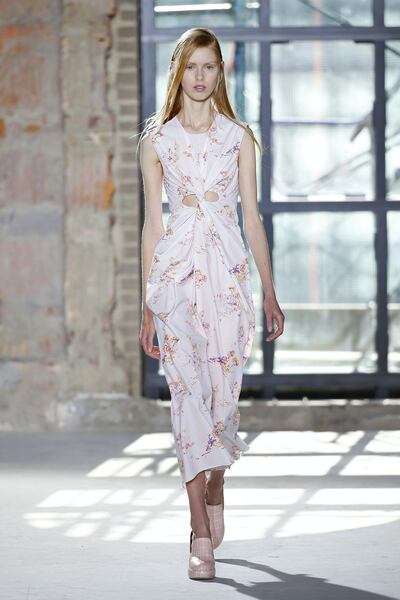
The Business of Fashion
Agenda-setting intelligence, analysis and advice for the global fashion community.

Agenda-setting intelligence, analysis and advice for the global fashion community.

NEW YORK, United States — "I remember the moment," says Sies Marjan designer Sander Lak, thinking back to the minutes before his February 2016 New York Fashion Week debut, which took place in a raw loft space atop of the 58-storey Barclay Tower in Tribeca. The single front row was studded with notables like Anna Wintour, Natalie Massenet and Stefano Tonchi, many of whom rarely attend new designer debuts.
Lak, who spent five years at Dries Van Noten before moving to New York in 2015, was busy backstage with his stylist, Lotta Volkova, prepping models. "Five seconds before the show, I hear there were quite a few important people. I come out and I have a scan of the front row and was like, 'Holy fuck,'" he continues. "All these people. I went to the back and started panicking. We had no idea."

Sies Marjan Autumn/Winter 2016 | Source: Indigital
The buzz around Lak’s first show was not only a shock to the designer. For many in the audience, the debut of Sies Marjan was pleasantly startling as well; a collection that looked like nothing else at New York Fashion Week, conceived by a designer whose tenacity and spirit radiated from his confident, wild colour choices and his ability to swish back-and-forth between good taste and joyful tackiness. Consider the silk jacquard, depicting a wonky rainbow vignette of club kids but fashioned into a pair of sensible cropped trousers and an elongated shirt jacket. “I thought the collection was very holistic from a design point of view and had obviously been in his mind for a while,” says Ruth Chapman, co-founder of Matchesfashion.com, one of the brand’s first buyers. “It was wardrobing, and then some.”
ADVERTISEMENT
Soon after the show, the designer agreed to a US department-store exclusive with Barneys New York and partnered with a generous handful of key international and boutique partners. Now, nearly eight months after his debut, Lak must prove that he is no one-hit wonder; that Sies Marjan has the potential to grow into a full-fledged brand that will help to propel the American luxury market foward.
But while Lak’s work will no doubt continue to attract interest, his designs only partially explain why the entire industry is virtually pressed up against the glass windows of the company’s Flatiron District atelier, waiting to see what happens next.
Five seconds before the show, I hear there were quite a few important people. I have a scan of the front row and… I started panicking. We had no idea.
The Sies Marjan story began with the acclaimed designer and painter Ralph Rucci, who is best known for his haute-couture skills and devoted private clientele. In 2002, he became the second American designer — the first in more than 60 years — to be invited by the Chambre Syndicale de la haute couture to show his collection in Paris. But while Rucci's designs have long been touted and respected by critics, his brand has never been recognised commercially like Michael Kors or Marc Jacobs. There are many reasons for this — both known and unknown — but his lack of support from American Vogue, as well as intermittent financial difficulties, have been widely documented.
However, in 2012, it seemed that Rucci might have finally found a business partner that would allow his brand to flourish. His backer was longtime client Nancy Marks, who founded Deia LLC that year with her husband, the investor Howard Marks. It was clear that Nancy Marks was driving the endeavour with an ambition to match her husband's success. His brilliant investment strategy — admired by the likes of Warren Buffett — had made him a billionaire. To run the company, she brought on industry veteran Jeffry Aronsson, who, during his career, has served as chief executive of Oscar de la Renta, Donna Karan and Marc Jacobs. But Aronsson, who is known for coming in and cleaning up financials, was gone after less than two years.
Aronsson departed in November 2013. By May 2014, Marks and current co-chairman Guy Muzio, a 27-year veteran of Goldman Sachs and founder of Ocean Gate Capital Management, had hired Joey Laurenti, who ran wholesale for Opening Ceremony before establishing his own showroom, Goods and Services, with partner Cindy Krupp (owner of the public relations firm Krupp Group). Through Goods and Services, Laurenti represents contemporary labels like Apiece Apart and Frame Denim. He began with Marks first as a consultant, but was soon being courted for the chief executive role. "I was approached to consult on the relaunch of Ralph Rucci, which I thought was kind of a stretch. But I was willing to take the meeting," Laurenti says. "I came here and I met Nancy and Guy, and I kind of fell in love. I was impressed by the infrastructure and the opportunity of the organisation."
“I had my hipster hat on, taking notes on my phone, being myself,” he continues. “They approached me [about the CEO role], and I thought, ‘That’s kind of crazy.’ But the opportunity to work with someone like Nancy... It just seemed like such a sure bet, that I’d kick myself if I didn’t do it.”
As part of the deal, Deia invested in Goods and Services, buying out Krupp’s stake. However, six months into Laurenti’s tenure, Rucci unceremoniously departed the company “to pursue other creative endeavours,” leaving his brand name behind.
At first, it was thought that Marks and Laurenti would attempt to continue developing the Ralph Rucci collection, but that plan was soon scratched. “We didn’t really see the opportunity of creating a brand under the Ralph Rucci label. Ralph Rucci is an incredibly talented designer, but he’s not a brand,” Laurenti says. “It doesn’t occupy the same space in the market that it would need to in order to push it forward. When he left the company, it was clear to us that the best path to move forward was to create a new brand using the existing infrastructure that was here, which is incredible.”
ADVERTISEMENT
I figured I'd give it one last shot and then I'd be done. I'm glad I did.
That infrastructure includes 19 pattern makers, sewers, cutters and hand-finishers, 11 of whom worked with Rucci for a minimum of five years, some for 14 years. “That workroom is one of the most talented, in my opinion, in the country,” Laurenti says. “It definitely rivals some of those in Europe. And that was really the value that I saw in this organisation.”
Why those Rucci loyalists chose to stay, beyond needing to pay the rent, is open to debate. Atelier talent is difficult to come by everywhere, but especially in New York, which means other high-end companies with workrooms here — including Carolina Herrera and Oscar de la Renta — are constantly scouting. But Laurenti believes the Rucci veterans were after the opportunity to create something new. "They were interested in our business plan," he says. "I'm very transparent with the team. I really like to share our strategy with them, what we're doing and who our customers are. It's important for them to understand what our objectives and goals are overall, as well as what [his or her] specific job [goals] are. That really helps to motivate everyone and make them feel they're a part of this — in every aspect."
As for why Marks continued to keep things going without Rucci, whose unique talent was a catalyst for her involvement in the first place: “I have a very simple, two-word answer: Joey Laurenti,” she says. “I believed in Joey's extraordinary combination of creative talent and leadership skills, and, because I hired him to build a world-class fashion house, I felt I had made a commitment to him that I wanted to honour. I figured I’d give it one last shot and then I’d be done. I’m glad I did.”
But while Marks may have believed wholeheartedly in Laurenti’s ability and a team that could carry out the work remained in place, the venture was still lacking a creative vision. “I gave Joey the reins and told him to run with it,” Marks says. “Sander was entirely his find and his choice. I knew nothing of him, and when I look back at it now, that’s kind of insane! Joey came through for me.”
It took Laurenti three months to find Lak, who turned down another position at a major European house in order to move to New York and work for Deia. Although the designer’s point of view and impressive experience were major factors in Laurenti’s pursuit, Laurenti also considered how compatible they would be as business partners. “Something that was equally important to me was who he is as a person,” Laurenti explains. “I liked his energy, and he felt like someone who other people would like, which is important.” Laurenti and Lak are also the same age — 33 — which means they share many of the same cultural references and are at parallel points in their careers. “What I like about that age,” Lak says, “is that we have experience to know what we are doing. But we are naive enough to take risks and be ambitious. Time and age hasn’t made us sour. It was really clear to us that the starting point of this dream becoming a reality was the balance between Joey and me.”
Still, Laurenti and Lak had only met a few times before the designer moved to New York. “Before I officially said yes, I had a week of nausea,” Lak says. “My gut feeling was saying yes. The core was saying it was a good thing. But my logic and everything else was like, ‘What are you doing? Do the other thing! It’s safe!’ We didn’t know each other at all.”

Sies Marjan Autumn/Winter 2016 | Source: Indigital
In the end, however, the gut — and his immediate rapport with Laurenti — won. “Joey and I, without knowing each other, were feeling the exact same thing,” Lak says. “Something was happening; there might be a great space in American luxury [for a new brand].” The magnitude of the opportunity also weighed on him. “For me, it was also wanting to do something that was coming closer to what I am instead of working within someone else’s frame,” he continues. “Opportunities like these don’t happen anymore. It used to happen in the ‘90s, maybe, but not anymore. Once this became more solid and more clear, I would’ve been stupid had I not done it. Really stupid… I would’ve been miserable.”
ADVERTISEMENT
In some ways, Sies Marjan is an old-fashioned operation: there are no intentions to operate on the consumer calendar and direct-to-consumer retail was not part of the launch plan. Instead, the label is starting with 28 retailers globally for the Autumn/Winter season, with 39 retailers committed to the second collection, which went to market in June. E-commerce, they say, will come in due time. “Online is really interesting to all of us and I think that the way the consumer shops today is so different from last month or yesterday. It changes at this incredible pace, so we are really focused on that,” Laurenti says. “We are just trying to be appropriate about the timing and pacing. We obviously have the means, but it doesn’t seem like the smartest decision at this juncture.”
“Also, one thing at a time,” Lak says. Indeed, the duo are taking things slow, producing two runway shows a year, with Spring/Summer and Autumn/Winter split into two deliveries instead of creating pre-collections. And while editors particularly admired the first collection’s shoes, they won’t be producing them just yet. “We are dying to pull the trigger, but we are also being thoughtful about the quality and quantity,” Laurenti says. “And also really looking at the market, and understanding what they want at a specific price point. So we decided to hold it back until we are sure that it will perform. That’s really important to us: we don’t just want to put product out.”
However, there is an continual dialogue about the state of the business — from pricing to merchandising to sourcing — that is possible thanks to Laurenti’s comfort around creatives and Lak’s fearlessness and confidence in his ability as a designer. While there are crêpe de chine dresses from the first collection priced at $2,600, there are also striped sweaters for $890. Not cheap, by any means, but also not the five figures a made-to-order look from Rucci could cost. Lak, however, does not appear weary of being given a few restrictions. “We both understand, something can’t be purely concept or commercial,” Lak says. “We work as partners to achieve that balance.”
“There also should be a range,” Laurenti says. “Sometimes you want something easy at $650 and sometimes you want something special at $2,000. It’s about the level of design, fabrication that we put in each garment. We came up with this strategy to market it in a commercial way.”
It also helps that the clothes give off a certain sense of pop-cultural relevance, with plenty of Instagram-worthy moments in Lak's use of sherbet hues and his development of silhouettes that are thought-provoking without reading as overly complicated. "Sander has been quite clever," Chapman says. "He's not on social media himself, but when I look at his work it’s really digitally friendly because of the use of colour. In the US in particular, designers have been slower to adapt to engaging customers in that way. His clothes really live online as well as in a store."
Perhaps what is different about Laurenti and Lak is their Millennial attitude. They are both friendly, smiling, open people, whose adoration for Marks is clearly reciprocated during a mid-summer interview in their offices, which are centred around the atelier. Lak has outfitted the showroom, reception area and library with furniture that speaks to his shaggy, colour-driven aesthetic that’s free of snobbery, including an imitation Picasso table from the 1970s, fake Mies Van Der Rohe chairs that were reupholstered with a carpet Lak found on the street, and a “1980s interpretation” of a Hans Wegner chair. In fact, the designer’s obsession with 1stdibs, the online marketplace for “beautiful things,” is so deep that he partnered with the company to pull in a selection of furniture from the London store Talisman — including dusty-rose Milo Baughman-style upholstered stools from the 1980s, jade-green cantilever armchairs from the 1970s and an Italian blue-marble pedestal — to sit alongside his wares at Selfridges in London through October 15.
There are other projects underway as well, including a Spring 2017 video shot by Christopher Simmonds in Midtown Manhattan's eerie Hotel Pennsylvania. But while Sies Marjan's debut might have had an explosive effect, don't expect fireworks from anything but the clothes. Indeed, Marks has made clear her understanding that the Sies Marjan business will take several years to build. Even choosing the name — a combination of Lak's mother (Marjan) and father's (Sies) first names — was a six-month process. To be sure, it gives him a certain ownership over the brand without making him sacrifice his own name, something many designers before him — perhaps even Rucci — have come to regret.
Sies Marjan Spring 2017, a film by Christopher Simmonds
Time, of course, is the greatest luxury of all. And it's what Laurenti, Lak and Marks believe will separate Sies Marjan from other newly launched labels. “Sometimes we forget, but we’ve only done one show for the outside world,” Lak says. “They’ve only seen one thing. What we are focused on is making that second show. And then we will go from there. Let people first really see and understand and buy the product.”
Related Articles:
From analysis of the global fashion and beauty industries to career and personal advice, BoF’s founder and CEO, Imran Amed, will be answering your questions on Sunday, February 18, 2024 during London Fashion Week.
The State of Fashion 2024 breaks down the 10 themes that will define the industry in the year ahead.
Imran Amed reviews the most important fashion stories of the year and shares his predictions on what this means for the industry in 2024.
After three days of inspiring talks, guests closed out BoF’s gathering for big thinkers with a black tie gala followed by an intimate performance from Rita Ora — guest starring Billy Porter.